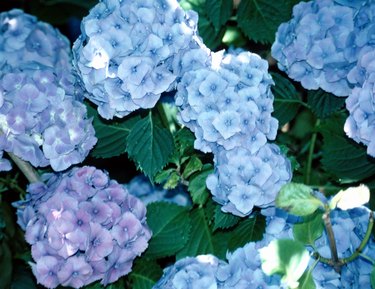Things You'll Need
Water
Pruning shears
Mulch material (grass clippings, bark, or leaves)
Fertilizer

Hydrangeas are a mainstay of the flower garden due in part to their hardy nature. The color and vibrancy common to all varieties add freshness and romance to many a home garden. Like other perennials, they are prized because once planted, they will typically blossom every year. The initial work of planting, however, must be followed up by proper care. The wise gardener will take measures to keep hydrangeas healthy and blooming reliably year after year. Your local horticulture specialist can fill you in on specifics of every aspect of hydrangea care for your particular region.
Step 1
Plant the hydrangea properly. The top of the plant's bulb should rest at the soil's surface.
Video of the Day
Step 2
Water regularly. Water the hydrangea thoroughly when you first put it into the ground. Thereafter, water it every week or so, depending upon how much sun the plant is exposed to during the day. For example, during the summer, when it is exposed to more sun, it will require more frequent watering. If it is exposed to less sun, it will require less frequent watering. Do not ever let the soil dry completely; if the flowers begin to wilt, you have waited too long to water. If you are unsure as to when to water your hydrangea, check with a horticultural specialist or nursery in your area, as hydrangeas care can vary by region and/or climate.
Step 3
Prune the plants every year. Be sure to prune them only when the flowers start to lose their blooms. Remove the entire flower head, as well as smaller shoots. This will help more branches to develop. In addition, to encourage plant fullness, when winter rolls around, you can identify the stems that are oldest and remove nearly a third of each of those stems.
Step 4
Mulch the plants. Apply between three to five inches of mulch material, such as grass clippings, leaves, or bark, on top of the soil around the plants. Mulch helps to discourage weed growth and trap in moisture. Leave the mulch on the soil throughout the year.
Step 5
Fertilize the plants. Apply a balanced fertilizer late in the spring or in the middle of the summer. Use the amount of fertilizer specified in the instructions that come with the product.
Tip
The acidity of the soil in which you plant your hydrangeas can impact their color. Check with a garden specialist if you would like to encourage pink, as opposed to blue, blossoms.
Different species of hydrangea may respond best to different pruning methods: For example, hills-of-snow hydrangea should be pruned all the way to the ground at winter or early in the spring. If you are not sure of the best pruning method for the type of hydrangea you are growing, consult a horticultural specialist or nursery in your area.
Warning
Hydrangeas are subject to pests and diseases, such as powdery mildew, fungal organisms, root rot, rust, Japanese beetles, aphids, ants and even mites. A horticultural specialist can advise you on the best solutions to these issues, should they arise. As hydrangea care can vary according to climate and/or region, it is best to consult an expert who understands the growing conditions where you live.
Video of the Day